RESOURCE: Experimental Drawing Techniques
10th October 2022
Experimental drawing
Details of a special session provided for us by Richenda Oldham
Experimental drawing, as opposed to traditional drawing, can be defined as the study of purely making marks on a surface. It is both a sensory and physical activity, which has recently been widened to include artwork created in various media. Often an artist will make a deliberate decision not to draw with a pencil, using various materials.
Any focus on experimental drawing should and can start with mark-making activities.
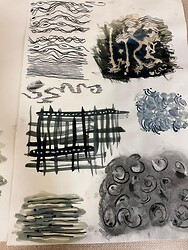
Create an art journal
Create an experimental drawing book. A good idea is to create a small sketchbook filled with various marks, built in the broadest possible range of materials—focusing on the quality of line and mark-making when completing this task.
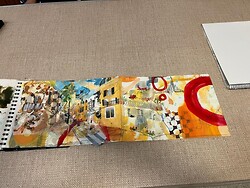
Continuous line drawing - Timed exercise
Set a timer for four minutes. Draw your chosen subject without taking your pencil off the page – this might mean creating extra lines to get from one bit of the drawing to another. You'll find your drawing has some interesting qualities.
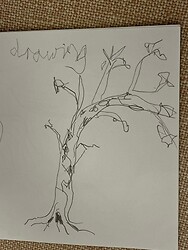
Opposite hand drawing
The opposite hand drawing method is a technique practiced in many art schools and is similar to the continuous line in that its purpose is to introduce the student to a new way of drawing. Again, select a drawing medium that you are not used to working with. Begin drawing with your opposite hand, and focus back on the act of observing and drawing what you see. The quality of these drawings will display freedom and loosening of the line that a more controlled traditional pencil drawing does not present.
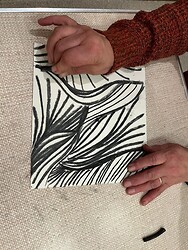
Abstracting your subject
Simplify your subject into the different shapes you can see. Rearrange these shapes in different ways to make an abstract version of your subject. Which arrangement works best?
Continuous line doodling
Put your pen or pencil on your paper and take it for a walk – as if you are doodling. You could draw something from your imagination or just make an abstract pattern. But don't take your pen off the paper. You will see that your continuous line has created lots of shapes. Fill these in with different colours to make a colourful abstract artwork.
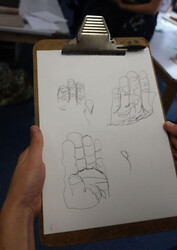
Collage/paint/charcoal drawing of scissors
Stick down areas of collage before drawing. The artwork below shows collage which has then had white and grey paint added to it and then a charcoal drawing with white and yellow highlights added in paint.
[Collage + paint + charcoal drawing + paint highlights]
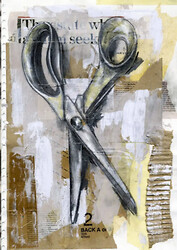
Collage/loose coffee/detailed pencil drawing
Place down appropriate pieces of collage for what you are going to draw. This is different from above as the collage is more part of the drawing rather than a background. Paint loosely with coffee, draw with coloured pencil.
[Draw with collage + loose coffee painting + detailed pencil]
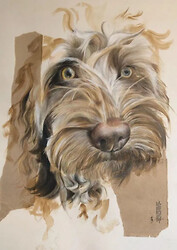
Glue/Scrumpled tissue paper/architectural drawing
Stretch paper, glue on tissue paper with PVA, let it dry. Raw sienna and French Ultramarine wash and brush on over the surface. Random and free, not neat! Allow to dry/blast with a hairdryer. Use sandpaper to break off rough bits with medium sandpaper. Draw on surface with a black pen (fine line 0.05 nib). Suggestion: architectural detail
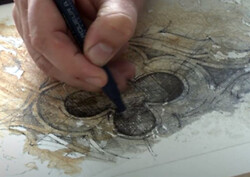
[Stretch paper + Distressed tissue background + Draw with pen]
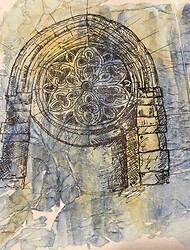
Wet on wet
Wet watercolour paper or really thick cartridge paper, blot with tissue so damp, draw with Payne’s grey watercolour. Use a tiny blob from tubed watercolour for this task. The watercolour bleeds into the damp paper. Allow to dry + detail with small brush dipped in Payne’s grey watercolour or use a fine black pen.
[Wet paper + draw with Payne’s grey watercolour + dry, then put detail on with small brush].
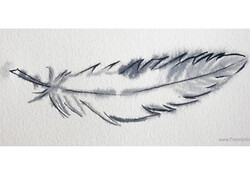
Ink splat & drawing
Ink splat or drip ink on paper, or work wet on wet with ink or watercolour, allow to dry, then draw.
[Ink or watercolour surface + ballpoint pen drawing].
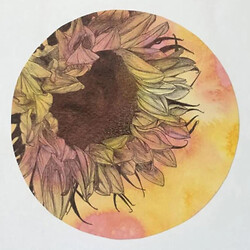
Landscape without detail
Try simplifying a landscape into basic shapes without details or shading.
Details of a special session provided for us by Richenda Oldham
Experimental drawing, as opposed to traditional drawing, can be defined as the study of purely making marks on a surface. It is both a sensory and physical activity, which has recently been widened to include artwork created in various media. Often an artist will make a deliberate decision not to draw with a pencil, using various materials.
Any focus on experimental drawing should and can start with mark-making activities.

Create an art journal
Create an experimental drawing book. A good idea is to create a small sketchbook filled with various marks, built in the broadest possible range of materials—focusing on the quality of line and mark-making when completing this task.

Continuous line drawing - Timed exercise
Set a timer for four minutes. Draw your chosen subject without taking your pencil off the page – this might mean creating extra lines to get from one bit of the drawing to another. You'll find your drawing has some interesting qualities.

Opposite hand drawing
The opposite hand drawing method is a technique practiced in many art schools and is similar to the continuous line in that its purpose is to introduce the student to a new way of drawing. Again, select a drawing medium that you are not used to working with. Begin drawing with your opposite hand, and focus back on the act of observing and drawing what you see. The quality of these drawings will display freedom and loosening of the line that a more controlled traditional pencil drawing does not present.

Abstracting your subject
Simplify your subject into the different shapes you can see. Rearrange these shapes in different ways to make an abstract version of your subject. Which arrangement works best?
Continuous line doodling
Put your pen or pencil on your paper and take it for a walk – as if you are doodling. You could draw something from your imagination or just make an abstract pattern. But don't take your pen off the paper. You will see that your continuous line has created lots of shapes. Fill these in with different colours to make a colourful abstract artwork.

Collage/paint/charcoal drawing of scissors
Stick down areas of collage before drawing. The artwork below shows collage which has then had white and grey paint added to it and then a charcoal drawing with white and yellow highlights added in paint.
[Collage + paint + charcoal drawing + paint highlights]

Collage/loose coffee/detailed pencil drawing
Place down appropriate pieces of collage for what you are going to draw. This is different from above as the collage is more part of the drawing rather than a background. Paint loosely with coffee, draw with coloured pencil.
[Draw with collage + loose coffee painting + detailed pencil]

Glue/Scrumpled tissue paper/architectural drawing
Stretch paper, glue on tissue paper with PVA, let it dry. Raw sienna and French Ultramarine wash and brush on over the surface. Random and free, not neat! Allow to dry/blast with a hairdryer. Use sandpaper to break off rough bits with medium sandpaper. Draw on surface with a black pen (fine line 0.05 nib). Suggestion: architectural detail

[Stretch paper + Distressed tissue background + Draw with pen]

Wet on wet
Wet watercolour paper or really thick cartridge paper, blot with tissue so damp, draw with Payne’s grey watercolour. Use a tiny blob from tubed watercolour for this task. The watercolour bleeds into the damp paper. Allow to dry + detail with small brush dipped in Payne’s grey watercolour or use a fine black pen.
[Wet paper + draw with Payne’s grey watercolour + dry, then put detail on with small brush].

Ink splat & drawing
Ink splat or drip ink on paper, or work wet on wet with ink or watercolour, allow to dry, then draw.
[Ink or watercolour surface + ballpoint pen drawing].

Landscape without detail
Try simplifying a landscape into basic shapes without details or shading.